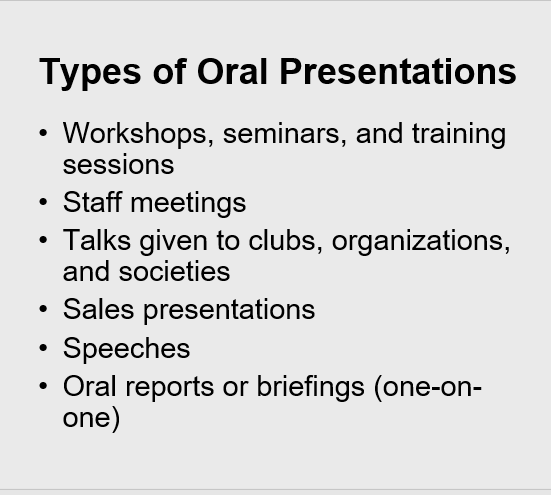Strategies and Tools for the Dreaded Oral Presentation!
Oral presentations are widely used across college disciplines with most students having at least one oral presentation each semester. Many students are not comfortable doing this task, luckily there are strategies and alternatives that can be implemented to help students succeed. After discussions with several colleagues in the network, I have confirmed my theory that using a combination of tools and strategies can bring about positive results when it comes to oral presentations.
According to Paul Turcotte, Philosophy Teacher at Cégep du Vieux Montréal and Researcher with CRISPESH, we need to rethink the traditional oral presentation and we should start with the ministerial competencies of a course. In reviewing the competencies, we often see that a formal, traditional oral presentation is not compulsory. Programs may wish to include this type activity as a way to express or evaluate certain elements of a course, or to prepare students for future careers, but often teachers are able to evaluate the necessary elements of a competency through alternative forms of oral expression or other evaluation methods.
Teaching the courses English for Tourism and Professional Communication, in the bilingual Tourism Program, a joint program between Cégep Limoilou and CEGEP Champlain-St. Lawrence, there are 2 competencies to achieve that focus on oral expression with individuals and groups. Over the years, I have learned some simple strategies to help students succeed, as well as some alternatives that stem from inclusive pedagogical practices.
Tip 1: Information Is Key

Whether a student struggles with giving an oral presentation or not, it is important to prepare students. The Special Education Technician at CEGEP Champlain-St. Lawrence, explains that clear instructions are an essential starting point. Taking time to prepare documentation explaining necessary details is an important step in guiding them towards success.
Proposed strategy:
- Instructions presented in class, with a visual aid, on the screen and/or a paper version.
- Allow time for questions after the instructions are given.
- A copy of the instructions should also be made available on the local learning management system (Léa, Moodle, etc.), to make them readily available for consultation at a later time.
Tip 2: Teach Presentation Skills

Teachers cannot assume that students have been taught how to give a presentation for the college level. We should not take for granted that students have been provided with tools required for post-secondary expectations.
If you, or someone in your department or program, can lend some class time to teach students how to deliver a solid presentation, this can make all the difference in the quality of their presentations and in equipping them for success.
Proposed strategy:
I have been told that my strategy of surveying the class about their feelings towards oral presentations, gives students who suffer from anxiety or an extreme fear of public speaking, the opportunity to see that they are not alone.
With a simple show of hands, I ask:
- Who likes oral presentations?
- Who is extremely comfortable at the front of the room?
- Who is relatively comfortable?
- Who is completely uncomfortable?
Giving readings, from a textbook or online articles, can help introduce the topic to students. Students can learn about presentations in the professional world, the importance of preparing, how to use visual aids effectively, and how to deliver a solid presentation.
Follow up on the readings, using PowerPoint or Prezi, and add some personal anecdotes. There are videos available, showing examples of good and bad presentations, and there is one I like to show that I upload to Léa for students to watch again if they wish:
Be a More Confident Public Speaker explains how to give a presentation, especially for those who fall into the 70% of people who have a fear of public speaking.


Slides from a PowerPoint presentation highlighting information about oral presentations. Information for the PowerPoint was taken from the book Communicating for Results: A Canadian Students Guide. Second Edition by Carolyn Meyer.
To help students feel comfortable at the front of the room, I also review body language. I teach the types of physical presence elements that help make a solid presentation. I walk them through a list of these elements, giving advice on how to carry out each one, or at least how to fake it!
Tip 3: Practise, Practise, Practise

Practice makes perfect! Stress the importance of practising out loud, in front of someone that they are comfortable with, which can be themselves in the mirror, their dog or cat, boyfriend or girlfriend, mom or dad. The more they practise and know their presentation well, the more confident and comfortable they will feel at the front of the room.
Practise presentations are another strategy. My method includes small groups and each presentation is filmed! Students use smartphones or tablets to film each other. They then watch the video and complete a formative evaluation, based on a grid I have given them in advance. These grids are used to help students make improvements to their content, organization, and presentation skills. They can discuss their presentation and see their peers in action. The formative evaluations are handed in to me and I use them as a reference for the final presentations.
Alternative Methods
Sometimes having an alternative is all a student needs to be successful in this area of evaluation. Johanne Morin, an English Teacher at Cégep Limoilou, provides her students with options. She decided to offer alternatives, after having students cry at the front of the class during oral presentations.
Johanne offers students 3 ways of conducting their oral presentation.
- In front of the entire class
- In small groups
- One-on-one with her
She organizes her class time to accommodate the options, giving all students an equal opportunity. The majority of her students opt for the one-on-one presentation, believing it will be less stressful. Many find that it is not less stressful, but prefer to be alone with the teacher. She is happy to be able to provide students with alternatives that can make an important difference for them.
Paul Turcotte has also experimented with alternative methods for one of his courses. He gave students the same options as Johanne, but added the possibility of creating a video recording of their presentation to be shown in class. Although an interesting option, this method could be problematic. Johanne explained that for language courses, if she allowed students to video record their presentations, she would have no control over the editing used to perfect the presentation.
Paul also offered another option to his students, which was to allow the student be “live”, but at a distance. Students could use Skype or Google Hangout, allowing them to avoid standing in front of a large group of people, but the class could still benefit from the information provided. Afterwards, he found that this method had the advantage of preparing students for a very common type of professional communication: the videoconference. This also has certain skills to address, as the camera is always rolling!
Perhaps it is time to adjust the traditional oral presentation, adding alternatives that are more inclusive for students in different situations; those learning by distance education by choice, or due to an illness or physical handicap, those suffering from anxiety, those with a learning disability, or those with other types of handicaps. By opening up the possibilities of oral expression assessments, we can help all students succeed.

